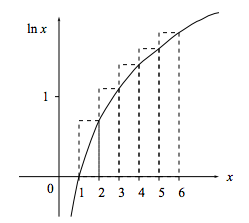10.5: E- Stirling's Approximation
- Page ID
- 6396
The Stirling formula is an approximation for n! that is good at large values of n.
\[ n !=1 \cdot 2 \cdot 3 \cdots(n-1) \cdot n\]
\[ \ln (n !)=\underbrace{\ln 1}_{0}+\ln 2+\ln 3+\cdots+\ln (n-1)+\ln (n)\]

Note that the function ln x is nearly flat for large values of x. For example, ln 1023 is about equal to 23.
From the figure
\[ \ln (6 !)=\text { area under the staircase }>\int_{1}^{6} \ln x d x\]
and in general
\[ \ln (n !)>\int_{1}^{n} \ln x d x=[x \ln x-x]_{1}^{n}=n \ln n-n+1. \]
For large values of n, where the ln n function is nearly flat, the two expressions above become quite close. Also, the 1 becomes negligible. We conclude that
\[ \ln (n !) \approx n \ln n-n \quad \text { for } n \gg 1.\]
This is Stirling’s formula. For corrections to the formula, see M. Boas, Mathematical Methods in the Physical Sciences, sections 9-10 and 9-11. You know that
\[ A^n\]
increases rapidly with n for positive A, but
\[ n ! \approx\left(\frac{n}{e}\right)^{n}\]
increases a bit more rapidly still.
E.1 Problem: An upper bound for the factorial function
Stirling’s approximation gives a rigorous lower bound for n!.
a. Use the general ideas presented in the derivation of that lower bound to show that
\[ \int_{1}^{n} \ln (x+1) d x>\ln n !.\]
b. Conclude that
\[ (n+1) \ln (n+1)-n+1-2 \ln 2>\ln n !>n \ln n-n+1.\]


